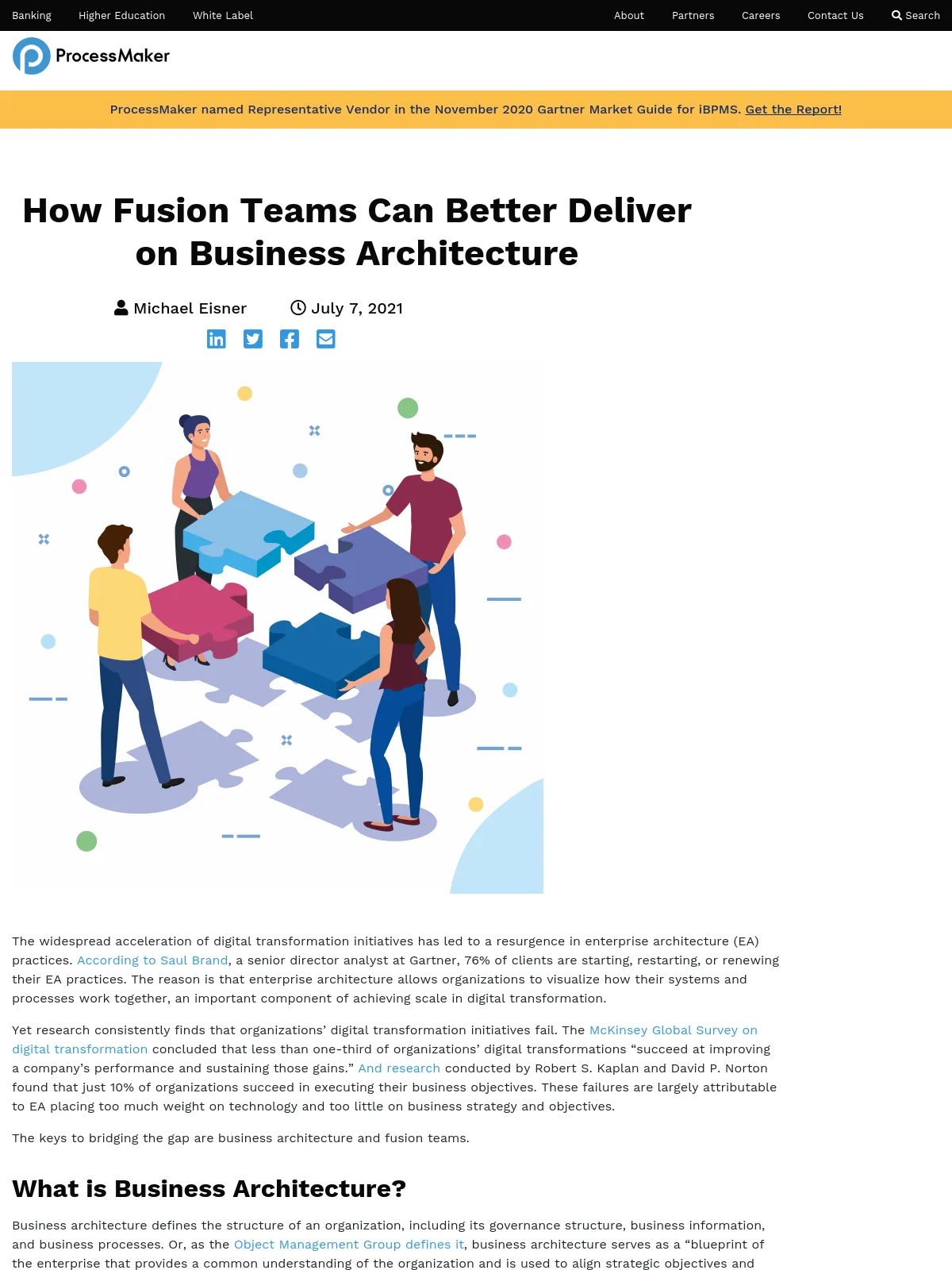How Fusion Teams Can Better Deliver on Business Architecture
Blog: ProcessMaker Blog
The widespread acceleration of digital transformation initiatives has led to a resurgence in enterprise architecture (EA) practices. According to Saul Brand, a senior director analyst at Gartner, 76% of clients are starting, restarting, or renewing their EA practices. The reason is that enterprise architecture allows organizations to visualize how their systems and processes work together, an important component of achieving scale in digital transformation.
Yet research consistently finds that organizations’ digital transformation initiatives fail. The McKinsey Global Survey on digital transformation concluded that less than one-third of organizations’ digital transformations “succeed at improving a company’s performance and sustaining those gains.” And research conducted by Robert S. Kaplan and David P. Norton found that just 10% of organizations succeed in executing their business objectives. These failures are largely attributable to EA placing too much weight on technology and too little on business strategy and objectives.
The keys to bridging the gap are business architecture and fusion teams.
What is Business Architecture?
Business architecture defines the structure of an organization, including its governance structure, business information, and business processes. Or, as the Object Management Group defines it, business architecture serves as a “blueprint of the enterprise that provides a common understanding of the organization and is used to align strategic objectives and tactical demands.”
Business architecture offers three key value propositions. The first is to facilitate change. It does this by connecting business strategy and execution. The second is to simplify complex environments. This is key to achieving automation at scale. Third, business architecture creates shared language and visibility throughout the organization.
Those that build business architecture are known as business architects. Business architects play an important role in facilitating continuous improvement, innovation, and business transformation. As such, they are key members of fusion teams.
What is a Fusion Team?
Gartner defines a fusion team as “cross-functional teams that use data and technology to achieve business outcomes.” A fusion team may be led by technical professionals, but as Gartner explains, fusion teams are often autonomous. They “drive technology decisions and choices both outside of IT and that might differ from IT recommendations.”
A fusion team is generally temporary and fuses a broad range of professionals. For example, technical professionals, business architects, analysts, change management, data security, and legal. Their purpose is to work together to implement a specific change and then transition to other tasks.
Traditional hierarchical approaches where business users direct distinct IT teams are on the way out. These approaches are inefficient and unable to keep up with the rapid pace of digital transformation. To overcome these limitations, organizations are increasingly turning to fusion teams.
According to Gartner, “at least 84% of large and midsize companies, and 59% of government entities have already set up multidisciplinary teams. At least 74% of organizations in industries that are traditionally subject to heavy regulation – have fusion teams.” And as Gartner notes in a recent report, as fusion teams gradually displace DevOps teams, “enterprise architecture and technology innovation leaders must actively support these blended, multidisciplinary teams.”
In addition to EA and IT support, there are several ways your organization can empower your fusion teams to better deliver on business architecture.
How a Fusion Team Can Better Deliver on Business Architecture
Develop a Value Proposition for Business Architecture
It is important to engage in conversations with your fusion teams about the importance of business architecture to the organization. This should include a discussion of challenges and opportunities that exist within the organization, the impact of addressing these opportunities, the unique value proposition of business architecture, and the benefits of introducing business architecture.
Increase Accountability
To better deliver on business architecture, stakeholders must be accountable and hold fusion teams accountable. Stakeholders achieve this by encouraging fusion teams to drive competition and increase the organization’s bottom line by linking business efforts and objectives to business architecture deliverables.
And they hold themselves accountable by ensuring the continued relevance of business architecture and integrating that with other EA domains.
Ensure That Your Fusion Team Has the Right Skills
Fusion teams require the right skill sets to deliver on business architecture. Start by assessing your existing pool of business architects’ skills. If necessary, hire new business architects to empower your fusion teams.
Leverage Digital Transformation Tools
IT professionals will play a key role in supporting fusion teams and ensuring that supporting technology platforms can meet organizational needs and objectives. Low-code platforms allow both non-technical and IT professionals to participate in the development process. In traditional IT environments, business users would go around IT to implement their own out-of-the-box solutions. This leads to shadow IT, security risks, and a disconnect between technology and business objectives.
ProcessMaker offers an award-winning low-code business process management (BPM) platform that helps organizations to empower their fusion teams to better deliver on business architecture.
The post How Fusion Teams Can Better Deliver on Business Architecture appeared first on ProcessMaker.
